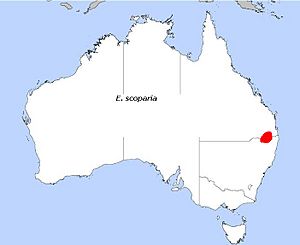Wallangarra white gum facts for kids
Quick facts for kids Wallangarra white gum |
|
|---|---|
 |
|
| Eucalyptus scoparia in Girraween National Park | |
| Conservation status | |
| Scientific classification | |
| Genus: |
Eucalyptus
|
| Species: |
scoparia
|
 |
|
| E. scoparia, field distribution | |
The Wallangarra white gum, also known as the willow gum, is a special tree. It is found only in a small area of eastern Australia. This tree has smooth, white bark. Its leaves are long and thin, or shaped like a spear. The flowers are white and grow in groups of seven. After flowering, it produces fruit that looks like a small cup or bell.
This tree naturally grows on rocky mountains near the border of New South Wales and Queensland. However, people also plant it in many other places.
Contents
What the Wallangarra White Gum Looks Like
The Wallangarra white gum is a tree that usually grows to be about 15 to 20 meters tall. That's like a five-story building! It has a special woody swelling at its base called a lignotuber. This helps the tree regrow if it gets damaged.
Its bark is smooth and powdery. It's white and grey and peels off in long, thin strips.
- Young plants: The leaves on young trees are usually opposite each other. They are shiny green and shaped like a line or a narrow rectangle. They are about 40 to 80 mm long and 6 to 18 mm wide.
- Adult leaves: The leaves on older trees are shiny light green on both sides. They are long and thin, or shaped like a spear. They measure about 60 to 160 mm long and 5 to 15 mm wide. Each leaf has a small stem called a petiole, which is about 5 to 17 mm long.
The flower buds grow in groups of seven. They are attached to a small stalk called a peduncle, which is about 5 to 10 mm long. Each bud has its own tiny stem, called a pedicel, about 1 to 4 mm long.
Mature buds are oval or pear-shaped. They are about 4 to 5 mm long and 3 to 4 mm wide. They have a cap, called an operculum, which can be cone-shaped or have a small beak.
This tree usually flowers in November, and its flowers are white. After the flowers, the tree produces woody fruit. These fruits are shaped like a cup, half-sphere, or bell. They are about 3 to 5 mm long and 4 to 6 mm wide. The parts that release the seeds stick out a little from the rim of the fruit.
How the Wallangarra White Gum Got Its Name
The Wallangarra white gum was first officially described in 1905. A scientist named Joseph Maiden gave it the scientific name Eucalyptus scoparia. He wrote about it in a scientific paper.
The word "scoparia" comes from a Latin word meaning "broom-like." It's not totally clear why this name was chosen for the tree.
Where the Wallangarra White Gum Lives
The Wallangarra white gum is found in only a few places. It grows on mountains near the border between New South Wales and Queensland in Australia. You can find it growing in cracks and gaps on large granite rocks. It lives in open forests and woodlands.
Protecting the Wallangarra White Gum
This special eucalypt tree is considered "vulnerable." This means it's at risk of disappearing if we don't protect it. Both the Australian Government and the New South Wales Government have laws to protect it.
The main reasons this tree is in danger are:
- Loss of habitat: Its natural home is being cleared for other uses.
- Trampling: Young plants can be stepped on and damaged.
- Small population: There aren't many of these trees left in the wild.
Using the Wallangarra White Gum in Gardens
Even though it's rare in the wild, the Wallangarra white gum is very popular. Many people plant it as an ornamental tree in gardens and parks in southeastern Australia.
See also
 In Spanish: Eucalipto blanco de Wallangarra para niños
In Spanish: Eucalipto blanco de Wallangarra para niños




